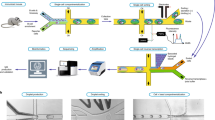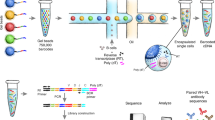Abstract
Isolation of antigen-specific monoclonal antibodies (mAbs) and antibody fragments relies on high-throughput screening of immortalized B cells1,2 or recombinant antibody libraries3,4,5,6. We bypassed the screening step by using high-throughput DNA sequencing and bioinformatic analysis to mine antibody variable region (V)-gene repertoires from bone marrow plasma cells (BMPC) of immunized mice. BMPCs, which cannot be immortalized, produce the vast majority of circulating antibodies. We found that the V-gene repertoire of BMPCs becomes highly polarized after immunization, with the most abundant sequences represented at frequencies between ∼1% and >10% of the total repertoire. We paired the most abundant variable heavy (VH) and variable light (VL) genes based on their relative frequencies, reconstructed them using automated gene synthesis, and expressed recombinant antibodies in bacteria or mammalian cells. Antibodies generated in this manner from six mice, each immunized with one of three antigens were overwhelmingly antigen specific (21/27 or 78%). Those generated from a mouse with high serum titers had nanomolar binding affinities.
This is a preview of subscription content, access via your institution
Access options
Subscribe to this journal
Receive 12 print issues and online access
$209.00 per year
only $17.42 per issue
Buy this article
- Purchase on Springer Link
- Instant access to full article PDF
Prices may be subject to local taxes which are calculated during checkout


Similar content being viewed by others
References
Köhler, G. & Milstein, C. Continuous cultures of fused cells secreting antibody of predefined specificity. Nature 256, 495–497 (1975).
Kwakkenbos, M.J. et al. Generation of stable monoclonal antibody-producing B cell receptor-positive human memory B cells by genetic programming. Nat. Med. 16, 123–128 (2010).
Clackson, T. et al. Making antibody fragments using phage display libraries. Nature 352, 624–628 (1991).
Feldhaus, M.J. et al. Flow-cytometric isolation of human antibodies from a nonimmune Saccharomyces cerevisiae surface display library. Nat. Biotechnol. 21, 163–170 (2003).
Harvey, B.R. et al. Anchored periplasmic expression, a versatile technology for the isolation of high-affinity antibodies from Escherichia coli-expressed libraries. Proc. Natl. Acad. Sci. USA 101, 9193–9198 (2004).
Schaffitzel, C., Hanes, J., Jermutus, L. & Plückthun, A. Ribosome display: an in vitro method for selection and evolution of antibodies from libraries. J. Immunol. Methods 231, 119–135 (1999).
Hoogenboom, H.R. Selecting and screening recombinant antibody libraries. Nat. Biotechnol. 23, 1105–1116 (2005).
Traggiai, E. et al. An efficient method to make human monoclonal antibodies from memory B cells: potent neutralization of SARS coronavirus. Nat. Med. 10, 871–875 (2004).
Wrammert, J. et al. Rapid cloning of high-affinity human monoclonal antibodies against influenza virus. Nature 453, 667–671 (2008).
Meijer, P.-J. et al. Isolation of human antibody repertoires with preservation of the natural heavy and light chain pairing. J. Mol. Biol. 358, 764–772 (2006).
Mazor, Y., Blarcom, T.V., Mabry, R., Iverson, B.L. & Georgiou, G. Isolation of engineered, full-length antibodies from libraries expressed in Escherichia coli. Nat. Biotechnol. 25, 563–565 (2007).
Jin, A. et al. A rapid and efficient single-cell manipulation method for screening antigen-specific antibody-secreting cells from human peripheral blood. Nat. Med. 15, 1088–1092 (2009).
Love, J.C., Ronan, J.L., Grotenbreg, G.M., van der Veen, A.G. & Ploegh, H.L. A microengraving method for rapid selection of single cells producing antigen-specific antibodies. Nat. Biotechnol. 24, 703–707 (2006).
Cobaugh, C.W., Almagro, J.C., Pogson, M., Iverson, B. & Georgiou, G. Synthetic antibody libraries focused towards peptide ligands. J. Mol. Biol. 378, 622–633 (2008).
Persson, H., Lantto, J. & Ohlin, M. A focused antibody library for improved hapten recognition. J. Mol. Biol. 357, 607–620 (2006).
Manz, R.A., Hauser, A.E., Hiepe, F. & Radbruch, A. Maintenance of serum antibody levels. Annu. Rev. Immunol. 23, 367–386 (2005).
Shapiro-Shelef, M. & Calame, K. Regulation of plasma-cell development. Nat. Rev. Immunol. 5, 230–242 (2005).
Manz, R.A., Thiel, A. & Radbruch, A. Lifetime of plasma cells in the bone marrow. Nature 388, 133–134 (1997).
Weinstein, J.A., Jiang, N., White, R.A., Fisher, D.S. & Quake, S.R. High-throughput sequencing of the zebrafish antibody repertoire. Science 324, 807–810 (2009).
Boyd, S.D. et al. Measurement and clinical monitoring of human lymphocyte clonality by massively parallel VDJ pyrosequencing. Sci. Transl. Med. 1, 12ra23 (2009).
Glanville, J. et al. Precise determination of the diversity of a combinatorial antibody library gives insight into the human immunoglobulin repertoire. Proc. Natl. Acad. Sci. USA 106, 20216–20221 (2009).
Ge, X., Mazor, Y., Hunicke-Smith, S.P., Ellington, A.D. & Georgiou, G. Rapid construction and characterization of synthetic antibody libraries without DNA amplification. Biotechnol. Bioeng. 106, 347–357 (2010).
Radbruch, A. et al. Competence and competition: the challenge of becoming a long-lived plasma cell. Nat. Rev. Immunol. 6, 741–750 (2006).
Phan, T.G. et al. High affinity germinal center B cells are actively selected into the plasma cell compartment. J. Exp. Med. 203, 2419–2424 (2006).
Carlson, R. The changing economics of DNA synthesis. Nat. Biotechnol. 27, 1091–1094 (2009).
Shendure, J. & Ji, H. Next-generation DNA sequencing. Nat. Biotechnol. 26, 1135–1145 (2008).
Krebber, A. et al. Reliable cloning of functional antibody variable domains from hybridomas and spleen cell repertoires employing a reengineered phage display system. J. Immunol. Methods 201, 35–55 (1997).
Brochet, X., Lefranc, M.P. & Giudicelli, V. IMGT/V-QUEST: the highly customized and integrated system for IG and TR standardized V-J and V-D-J sequence analysis. Nucleic Acids Res. 36, W503–W508 (2008).
Cox, J.C., Lape, J., Sayed, M.A. & Hellinga, H.W. Protein fabrication automation. Protein Sci. 16, 379–390 (2007).
Hayhurst, A. et al. Isolation and expression of recombinant antibody fragments to the biological warfare pathogen Brucella melitensis. J. Immunol. Methods 276, 185–196 (2003).
Gao, X., Yo, P., Keith, A., Ragan, T.J. & Harris, T.K. Thermodynamically balanced inside-out (TBIO) PCR-based gene synthesis: a novel method of primer design for high-fidelity assembly of longer gene sequences. Nucleic Acids Res. 31, e143 (2003).
Mazor, Y., Barnea, I., Keydar, I. & Benhar, I. Antibody internalization studied using a novel IgG binding toxin fusion. J. Immunol. Methods 321, 41–59 (2007).
Acknowledgements
We thank C. Das for her invaluable technical assistance on mammalian cell culture and transfection and M. Byrom for assistance with mouse experiments. This work was funded by grants from the Clayton Foundation, the Cockrell Chair in Engineering (to G.G.) and by a fellowship from Natural Sciences and Engineering Research Council of Canada (to X.G.).
Author information
Authors and Affiliations
Contributions
S.T.R. and G.G. developed the methodology, designed experiments, analyzed the data and wrote the manuscript; X.G., C.C., and K.H.H. carried out the bioinformatic analysis; S.T.R., A.E.M., R.A.H., S.H.K. and K.H.H. performed the experiments; S.P.H.-S. performed 454 DNA sequencing; B.L.I., P.W.T. and A.D.E. helped analyze the data.
Corresponding author
Ethics declarations
Competing interests
The authors declare no competing financial interests.
Supplementary information
Supplementary Text and Figures
Supplementary Tables 1–13 and Supplementary Figs. 1–12 (PDF 4918 kb)
Rights and permissions
About this article
Cite this article
Reddy, S., Ge, X., Miklos, A. et al. Monoclonal antibodies isolated without screening by analyzing the variable-gene repertoire of plasma cells. Nat Biotechnol 28, 965–969 (2010). https://doi.org/10.1038/nbt.1673
Received:
Accepted:
Published:
Issue Date:
DOI: https://doi.org/10.1038/nbt.1673
This article is cited by
-
The dengue-specific immune response and antibody identification with machine learning
npj Vaccines (2024)
-
Current advancements in B-cell receptor sequencing fast-track the development of synthetic antibodies
Molecular Biology Reports (2024)
-
Similarity measurements of B cell receptor repertoire in baseline mice showed spectrum convergence of IgM
BMC Immunology (2022)
-
Characterization of B cell receptor H-CDR3 repertoire of spleen in PRV-infected mice
BMC Veterinary Research (2022)
-
CellectSeq: In silico discovery of antibodies targeting integral membrane proteins combining in situ selections and next-generation sequencing
Communications Biology (2021)



